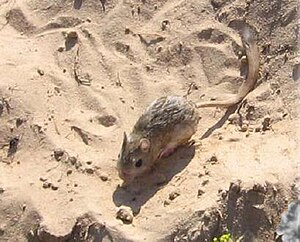Thick-tailed jerboa
| Thick-tailed jerboa | ||||||||||||
|---|---|---|---|---|---|---|---|---|---|---|---|---|

|
||||||||||||
| Systematics | ||||||||||||
|
||||||||||||
| Scientific name | ||||||||||||
| Stylodipus | ||||||||||||
| Allen , 1925 |
Thick-tailed jerboa ( Stylodipus ) are a genus of rodents in the family of jerboa , with three species found in Eastern Europe and Central Asia. In older papers, the synonym Scirtopoda (Brandt, 1843) often appears as a scientific name.
features
With a head-trunk length of 10 to 13 cm, a tail length of 13 to 16 cm and a weight of 60 to 70 g, the species belong to the medium-sized jerboa. Their hind feet are 4.5 to 6 cm long. Despite the common German name , the tail is only slightly thicker than that of the closely related jerboa ( jaculus ) and narrower than that of the fat-tailed jerboa ( pygeretmus ). As with the other representatives of the subfamily Dipodinae, only three toes appear on the hind feet. The fur is sand-colored to light brown on top, with several hairs having black tips. It gets lighter on the sides and is white on the bottom. The color of the upper side continues on the tail, which has no tassel. In individual specimens, the tip of the tail is lighter or darker, but never completely white. The soles of the hind feet are hairy to adapt to the often hot living space. The toes of these feet are equipped with claws and stiff hair in the spaces between them.
Way of life
Thick-tailed jerboa live mainly in deserts and steppes . Occasionally they visit coniferous forests or farmland. They dig simple holes in the ground for shorter breaks and complex tunnel systems for rearing the young and hibernating . These structures consist of 65 to 270 cm long corridors that are 20 to 70 cm below the ground, as well as several chambers and exits. Depending on the distribution, these jerboa hibernate from September or October to March.
In the other seasons, thick-tailed jerboa are mainly active in the first half of the night. They eat lichens, grains, young shoots ( rhizomes ) and onions. Depending on the species, reproduction takes place in spring or until late summer. Females have at least one litter with 2 to 8 pups during this time. Outside the mating season, the territories of several individuals of different sexes overlap. At least females tolerate same-sex intruders in the border area.
species
The genus includes the following species:
- The eastern thick-tailed gerbil ( Stylodipus andrewsi ) lives in Mongolia as well as in the Chinese provinces of Inner Mongolia , Gansu and Ningxia .
- The Mongolian thick-tailed jerboa ( Stylodipus sungorus ) is endemic to the Gobi Desert in Mongolia and probably also in China.
- The western thick-tailed jerboa ( Stylodipus telum ) occurs with several separate populations from eastern Ukraine to northwestern China.
The three species are listed as Least Concern by the IUCN .
swell
- Ronald M. Nowak: Walker's Mammals of the World. Volume 2. 6th edition. 1999, p. 1340, ISBN 0-8018-5789-9 .
- Andrew T. Smith et al .: A Guide to the Mammals of China , Princeton University Press, 2010, p. 205, Stylodipus
- Don E. Wilson , DeeAnn M. Reeder (Eds.): Mammal Species of the World . A taxonomic and geographic Reference . 3. Edition. 2 volumes. Johns Hopkins University Press, Baltimore MD 2005, ISBN 0-8018-8221-4 (English, Stylodipus ).
- Stylodipus on the2015 IUCN Red List of Threatened Species. Retrieved March 23, 2016.